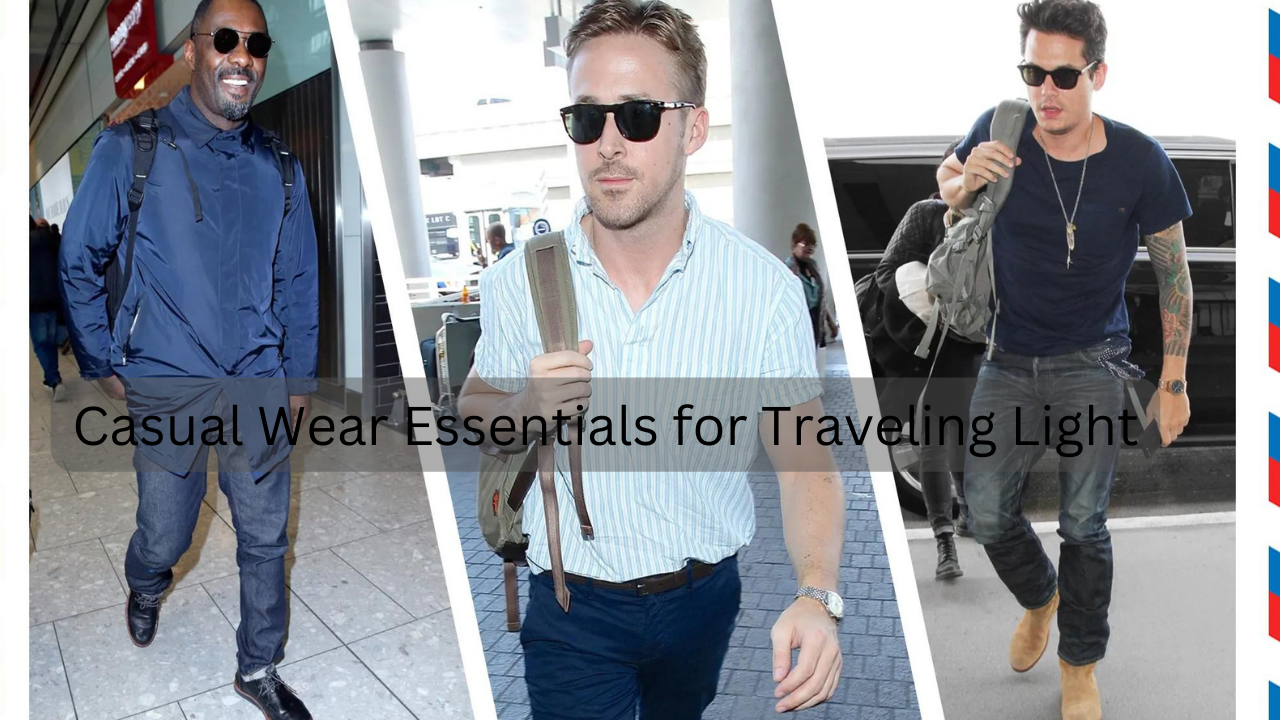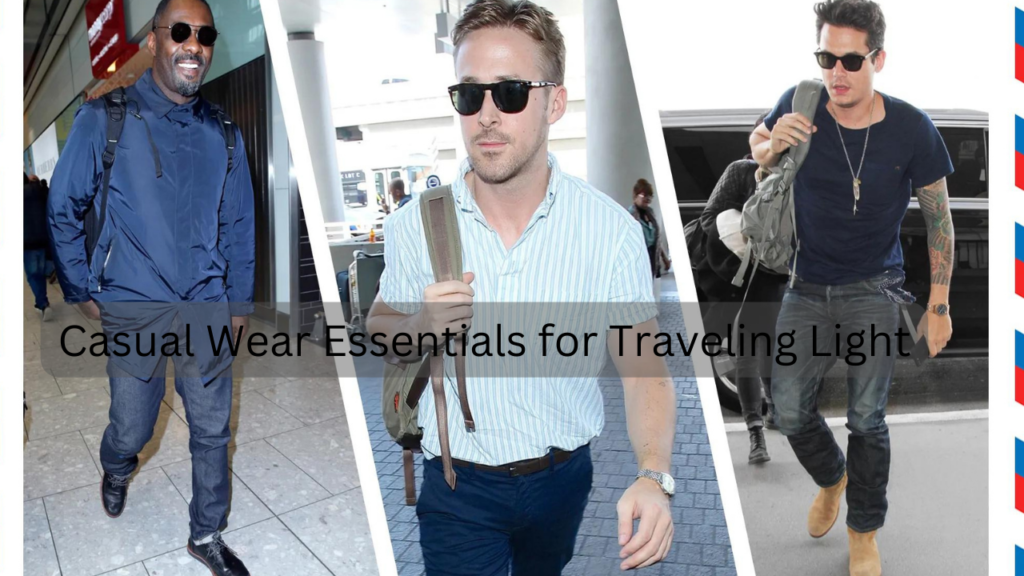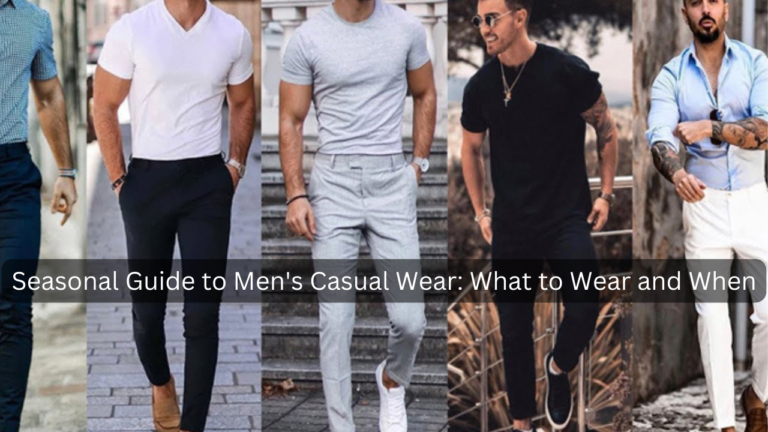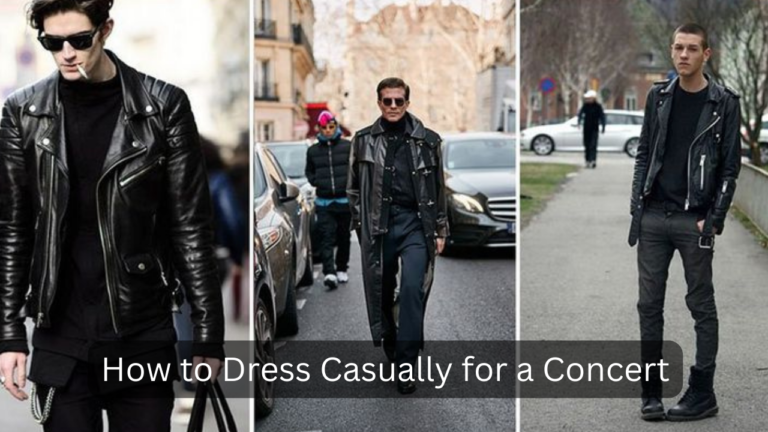

Table of Contents
Introduction:
When preparing for a trip, one of the most crucial decisions we face is what to pack. Whether it’s a weekend getaway or an extended vacation, the choices we make about our clothing can significantly impact our travel experience. In this guide, we explore the art of traveling light with casual wear essentials. By strategically selecting versatile pieces, you can streamline your packing process without sacrificing style or comfort.
Importance of Packing Light:
Packing light isn’t just about convenience—it’s a game-changer for travelers. Here’s why:
Efficiency: Packing light saves time and hassle at airports, train stations, or even when moving between accommodations. With fewer items to manage, you can navigate travel logistics more smoothly.
Freedom: Traveling light gives you the freedom to explore without being weighed down by bulky luggage. You can move more easily through crowded streets, navigate stairs effortlessly, and fit your belongings into smaller spaces.
Cost Savings: Avoiding checked luggage fees and reducing the risk of exceeding weight limits can save you money. Plus, traveling light encourages mindful consumption and packing only what you truly need.
Flexibility: With a compact wardrobe, you’re better prepared for unexpected weather changes or spontaneous activities. Versatile clothing allows you to adapt your outfit for different occasions without carrying excess baggage.
Benefits of Choosing Versatile Clothing:
Versatility is key when assembling a travel wardrobe. Here’s how versatile clothing enhances your travel experience:
Mix-and-Match Options: Versatile pieces like neutral-colored tops, bottoms, and layers can be mixed and matched to create multiple outfits from fewer items. This maximizes outfit combinations while minimizing the number of garments you need to pack.
Space Efficiency: Clothing that serves multiple purposes, such as a convertible dress or a jacket that doubles as a raincoat, optimizes space in your luggage. These dual-function items reduce bulk and leave room for other essentials.
Adaptability: Versatile clothing ensures you’re prepared for various activities and environments, from casual city strolls to unexpected dinner invitations. Pieces that can transition seamlessly from day to night or from indoors to outdoors are invaluable for travelers.
Comfort and Style: Quality fabrics that are breathable, wrinkle-resistant, and comfortable to wear enhance your travel comfort. Versatile clothing doesn’t compromise on style either—it allows you to express your personal fashion sense while staying practical.
Planning Your Wardrobe:
Consider the Climate and Activities:
Before packing, research the weather conditions and activities at your destination. This helps you choose appropriate clothing that will keep you comfortable throughout your trip:
Weather: Check the average temperature, humidity levels, and likelihood of rain or sunshine during your stay. Pack accordingly, with lightweight layers for hot climates or warmer clothing for cooler temperatures.
Activities: Consider the activities you plan to participate in, whether it’s sightseeing, hiking, dining out, or attending cultural formal events. Each activity may require specific attire, so versatile pieces that can transition from day to night or casual to formal are ideal.
Number of Days vs. Outfits Needed:
Determining how many outfits you need depends on the length of your trip and your access to laundry facilities:
Length of Trip: Calculate the number of days you’ll be away and plan outfits fit accordingly. A general rule is to pack enough clothing for about half the days of your trip, especially if you have access to laundry facilities or can wash clothes in your accommodation.
Mix and Match: Opt for clothing items that can be mixed and matched to create multiple outfits. For example, a few tops and bottoms that coordinate well together can yield several different looks. Accessories like scarves or jewelry can also change the appearance of an outfit without taking up much space.
Layering: Pack versatile layers such as cardigans or jackets that can be added or removed based on the weather. This approach allows you to adapt to temperature changes without packing multiple bulky items.
Essential Clothing Items
Tops:
T-shirts and Tank Tops:
Versatility: Pack a few neutral-colored t-shirts and tank tops that can be easily mixed and matched with different body bottoms. Opt for breathable fabrics like cotton or blends that are comfortable for all-day wear.
Layering: T-shirts and tanks are perfect for layering under shirts or jackets when the weather is cooler or for wearing on their own in warmer climates.
Occasions: Choose styles that suit both casual outings during the day and can be dressed up with accessories for evening events. Consider versatile colors like black, white, or navy that complement various outfits.
Long-Sleeve Shirt (Optional):
Weather Considerations: Depending on the climate of your destination, include a lightweight long-sleeve shirt for cooler evenings or to protect from the sun during daytime activities.
Versatility: Opt for a neutral-colored long-sleeve shirt that can be rolled up to short sleeves or layered over a t-shirt when needed.
Material: Look for best fabrics that are breathable and moisture-wicking, such as linen or lightweight cotton, to ensure comfort throughout the day.
Functionality: A long-sleeve shirt adds versatility to your wardrobe, allowing you to adapt to changing weather conditions without packing additional layers.
Bottoms:
Lightweight Pants or Jeans:
Versatility: Pack a pair of lightweight pants or jeans that can be worn multiple times without needing frequent washing. Choose a versatile color like navy, black, or khaki that coordinates well with your tops.
Comfort: Opt for fabrics that are breathable and comfortable for long hours of wear, especially if you’ll be walking or sitting for extended periods.
Style: Select a style tip that suits both casual outings and slightly more formal settings if needed. Consider features like stretch materials for added comfort and mobility.
Shorts:
Climate: Pack a pair of shorts suitable for the climate of your destination. Choose lightweight, quick-drying fabrics like cotton or blends for warmer weather, or opt for longer-length shorts that provide more coverage if desired.
Versatility: Select neutral-colored shorts that can be paired with various tops. Cargo shorts with pockets can be practical for carrying essentials during day trips or outdoor activities.
Functionality: Shorts are ideal for casual outings, beach visits, or activities where mobility and comfort are key. Ensure they fit well and provide freedom of movement for sightseeing or exploring.
Outerwear:
Lightweight Jacket or Sweater:
Versatility: Pack a lightweight jacket or sweater that can be layered over your tops for added warmth when temperatures cool down.
Material: Choose materials like fleece, lightweight wool, or synthetic blends that offer warmth without adding bulk to your luggage.
Style: Opt for a neutral color that coordinates with your other clothing items. A zip-up jacket or cardigan can be easily adjusted based on the weather and your comfort level.
Functionality: This piece serves as a versatile outer layer for cooler evenings, air-conditioned spaces, or unexpected weather changes.
Raincoat or Windbreaker (Depending on the Weather Forecast):
Weather Preparedness: Check the weather forecast for your destination and pack either a raincoat or a windbreaker accordingly.
Water Resistance: Choose a raincoat made from waterproof or water-resistant materials like nylon or polyester with sealed seams to keep you dry during rain showers.
Wind Protection: A windbreaker provides lightweight protection against gusty winds and can also serve as an additional layer for warmth.
Packability: Look for options that are lightweight and packable, allowing you to stow them easily in your daypack or luggage when not in use.
Footwear:
Comfortable Walking Shoes or Sneakers:
Comfort and Support: Choose comfortable walking shoes or sneakers that provide adequate support for walking long distances and standing for extended periods. Look for features like cushioned insoles, breathable materials, and good arch support.
Versatility: Opt for a neutral color that complements your clothing palette and can be worn with both casual and slightly dressier outfits.
Durability: Select shoes made from durable materials that can withstand various terrains and weather conditions. Consider waterproof or water-resistant options if you expect wet weather.
Flip-flops or Sandals (for Warm Destinations):
Breathability: Pack flip-flops or sandals made from lightweight and breathable materials such as rubber, EVA foam, or leather for warm weather destinations.
Comfort: Look good for styles with cushioned footbeds and adjustable straps for a comfortable fit. Choose sandals with sturdy soles that provide traction and support for walking on different surfaces.
Functionality: Flip-flops or sandals are perfect casual outfit for beach visits, poolside lounging, or Best Casual Wear Essentials for Traveling in warm climates. They’re easy to slip on and off, making them convenient for relaxing or exploring during your trip.
Accessories:
Scarf or Shawl:
Versatility: Pack a lightweight scarf or shawl that can be used in multiple ways, such as an extra layer of warmth, a fashion statement, or as a cover-up for modesty in cultural settings.
Material: Choose fabrics like cotton, silk, or lightweight wool that are breathable and comfortable against the skin. Consider a neutral color or a pattern that complements your outfits.
Functionality: A scarf or shawl can transform your look and add versatility to your travel wardrobe. It can also be used as a blanket during flights or as a makeshift pillow for added comfort.
Hat or Sunglasses:
Sun Protection: Pack a wide-brimmed hat or sunglasses to protect yourself from the sun’s rays, especially in destinations with sunny weather. Look for styles that offer UV protection to shield your eyes and face.
Style and Comfort: Choose a hat that suits your personal style and provides adequate coverage. For sunglasses, opt for durable frames with polarized lenses for enhanced clarity and reduced glare.
Practicality: Hats and sunglasses are essential accessories for outdoor activities, beach days, sightseeing tours, and even casual city strolls. They can also add a stylish touch to your overall outfit.
By including a scarf or shawl along with a hat or sunglasses in your travel accessories, you’ll enhance both your comfort and style while staying protected from the elements. These accessories not only serve functional purposes but also elevate your travel wardrobe with minimal effort.
Packing Tips:
Roll Clothes to Save Space:
Efficiency: Rolling your clothes rather than folding them can save space and minimize wrinkles. This technique also allows you to fit more items into your luggage while keeping them organized.
Method: Start with heavier and bulkier items at the bottom of your suitcase. Roll each clothing item tightly to create compact cylinders that can be stacked efficiently.
Benefits: Rolling clothes not only maximizes space but also makes it easier to locate specific items without disrupting the entire contents of your luggage.
Use Packing Cubes or Compression Bags:
Organization: Packing cubes or compression bags help separate and organize different types of clothing and accessories within your suitcase.
Compression: Compression bags allow you to squeeze out excess air, reducing the volume of your clothing and creating more space in your luggage.
Functionality: Use smaller packing cubes for items like socks, underwear, and accessories, and larger ones for clothing categories like tops and bottoms. This method keeps your belongings neat and accessible throughout your trip.
Layering Techniques for Varying Weather:
Strategic Packing: Pack versatile layers that can be easily added or removed based on the weather conditions at your destination.
Core Items: Start with core clothing items such as lightweight pants, t-shirts, and a versatile jacket or sweater that can serve as your base layer.
Adaptability: Add additional layers like a long-sleeve shirt, scarf, or lightweight outerwear that can be combined or removed as temperatures fluctuate.
Flexibility: Plan your outfits in layers to ensure you’re prepared for both warm days and staying cool evenings, maximizing the use of your clothing without overpacking.
Versatility and Coordination:
Mix and Match Colors and Patterns:
Color Palette: Choose a cohesive color palette for your clothing items, focusing on neutral tones such as black, white, navy, and khaki. These colors are versatile and can be easily mixed and matched.
Patterns: Select clothing with subtle patterns or textures that complement each other. Stripes, plaids, or small prints can add interest to your outfits without clashing.
Coordination: Aim to create multiple outfits from a few key pieces by coordinating tops and bottoms that work well together. For example, pair a solid color top with patterned bottoms or vice versa for a balanced look.
Clothing that Can Transition from Day to Evening:
Key Pieces: Pack clothing items that can easily transition from Casual Wear Essentials for Traveling to more formal evening attire with minor adjustments. For instance, a versatile dress or a pair of tailored pants can be dressed up with accessories like jewelry or a stylish jacket.
Layering: Use layering techniques to adapt your outfit for different settings. Add a blazer or cardigan over a simple top for a more polished evening look, or swap sneakers for dressier shoes like loafers or heels.
Accessories: Accessories such as scarves, belts, and statement jewelry can elevate your outfit from day to evening. Choose versatile accessories that complement both casual and dressier attire.
Practical Considerations:
Laundry Options:
Hotel Services: Check if your accommodations offer laundry services or have self-service laundry facilities available. Many hotels provide laundry bags and offer same-day or next-day cleaning services for your convenience.
Local Laundromats: Research nearby laundromats or laundry services in the area where you’re staying. This option is ideal for longer trips or when staying in accommodations without laundry facilities.
Packing Essentials: Bring travel-sized detergent packets or stain removers for spot cleaning in case laundry services are limited or unavailable.
Packing for Specific Activities:
Hiking: Pack lightweight, moisture-wicking clothing suitable for hiking, such as breathable t-shirts, convertible pants, and sturdy hiking shoes or boots. Consider packing a hat, sunglasses, and a lightweight rain jacket or windbreaker for varying weather conditions.
Sightseeing: Opt for comfortable yet stylish ideas clothing and footwear suitable for walking and exploring urban or historical sites. Choose versatile pieces that can be dressed up or down, such as casual dresses, comfortable pants or classic jeans, and comfortable walking shoes or sneakers.
Other Activities: Tailor your packing list based on specific activities you plan to engage in during your trip, such as swimming, dining out, or attending cultural events. Pack accordingly with appropriate attire and footwear for each activity.
Conclusion:
In conclusion, mastering the art of packing light enhances your travel experience in numerous ways. By prioritizing efficiency and versatility in your wardrobe choices, you not only lighten your load but also maximize convenience and enjoyment throughout your journey.
Recap the Benefits of Packing Light:
Packing light offers several compelling benefits:
Efficiency and Convenience: Streamlining your luggage saves time and effort during travel, whether navigating airports, public transportation, or exploring new destinations.
Flexibility and Adaptability: A compact wardrobe with versatile clothing options allows you to adapt to different climates, activities, and every occasions seamlessly.
Cost Savings: Avoiding checked luggage fees and reducing the risk of overpacking helps you stay within budget, leaving room for memorable experiences and souvenirs.
Stress Reduction: Traveling light reduces stress by minimizing the worry of lost or misplaced luggage and simplifying your daily routines.
Final Tips for Stress-Free Travel:
Plan Ahead: Research your destination’s weather, cultural norms, and activities to pack appropriately and avoid unnecessary items.
Use Packing Techniques: Employ packing cubes, compression bags, sports and rolling methods to maximize space and organization in your luggage.
Layering and Versatility: Pack clothing that can be layered for varying weather conditions and transitioned from day to evening with ease.
Stay Organized: Keep essentials like travel documents, medications, and valuables in a designated travel pouch or carry-on for quick access.
Embrace Minimalism: Prioritize essentials and multipurpose items to simplify your packing list and enhance your travel comfort.





